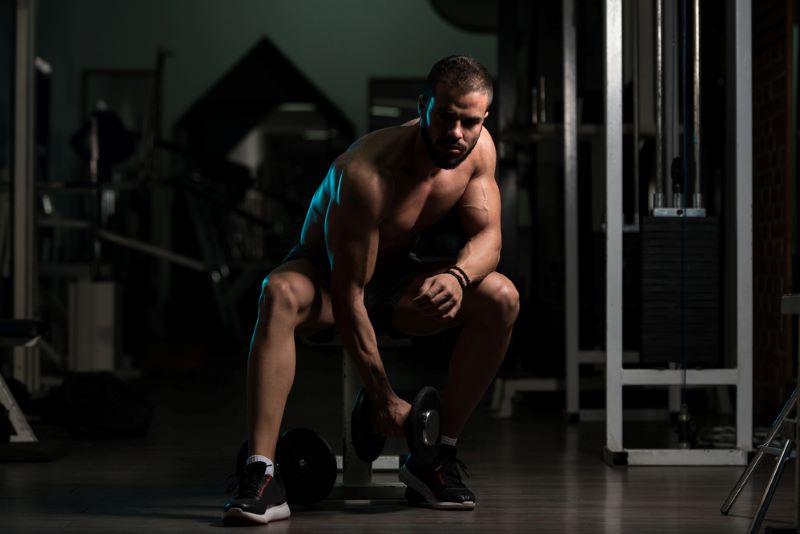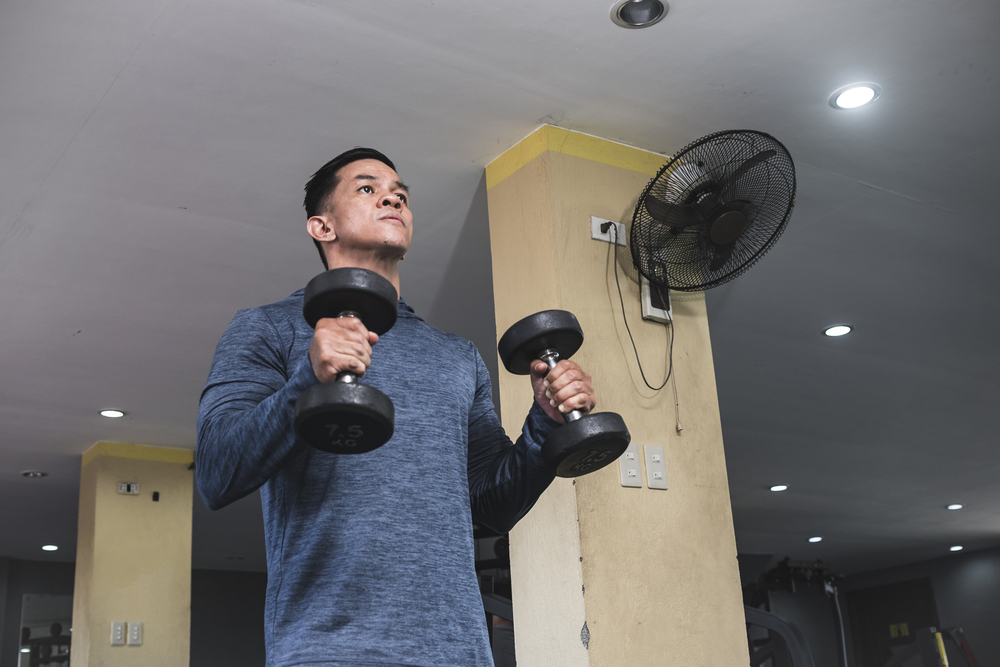If you’re looking for a comparison guide of seated hammer curls vs standing, then you’ve come to the right place.
In this article, we look at benefits of sitting and standing hammer curls, as well as whether seated or standing hammer curls are best for biceps growth.
Let’s get started.
Benefits of Seated Hammer Curls

Increased bicep activation
The seated position allows you to isolate the biceps and prevent cheating or using momentum to lift the weights.
The neutral grip also places less strain on the wrists and forearms compared to other biceps exercises.
You can change the incline of the bench
If you have access to an adjustable bench, you can attack the muscle from different angles.
Be careful not to use too shallow an incline, though, as the demands of the muscle around the elbow are greater the more you lay back.
Less likelihood of lower back strain
Whether the seat has backing or not, you’re much less likely to overextend your lower back when sitting.
In this sense, the the seated version is “stricter” as you’ve removed most of the involvement from the lower body. You can’t lean back any further to complete the rep.
Improved Arm Strength and Stability
Seated hammer curls can help improve overall arm strength and stability.
The exercise targets the biceps brachii, brachialis, and brachioradialis muscles, all of which contribute to elbow flexion and arm strength.
Stronger biceps muscles can also help support and stabilize the elbow joint, reducing the risk of injury.
Reduced Risk of Injury
Seated hammer curls are a safe exercise option for individuals with wrist or forearm injuries, as the neutral grip places less stress on these areas.
Also, the seated position provides more stability and support, reducing the risk of injury from lifting too heavy or using poor form.
You can have a sit down
I may be the laziest fitness professional of all time, but if I there’s an option to perform an exercise sat down, I am taking it.
When you’re trying to bulk you got to conserve calories, right?
Benefits of Standing Hammer Curls

You can use more weight
That subtle swing that comes from the hips when standing allows you to get a bit more momentum at the start of the movement. This allows for more weight to be used.
This would be useful if your intention is to overload the eccentric portion of the movement. You can swing up a heavier weight, then slowly lower it under control.
Increased Core Activation
Standing hammer curls can help increase core activation and stability.
The exercise requires you to maintain an upright posture and engage your core muscles to prevent swaying or using momentum to lift the weights.
This can help improve overall posture and reduce the risk of injury to the lower back.
Improved Coordination and Balance
Standing hammer curls can also help improve coordination and balance.
They require you to stabilize your body and maintain proper form while lifting the weights, which can improve overall coordination and balance.
This can translate to better performance in other exercises and daily activities.
Muscles Worked In Seated vs Standing Hammer Curls
Both seated and standing hammer curls work the biceps brachii, brachialis, and brachioradialis.
The biceps brachii is the primary muscle used in both exercises and is responsible for elbow flexion.
The brachialis is located underneath the biceps brachii and helps with elbow flexion. It’s activated more in sitting hammer curls than standing.
And the brachioradialis is located on the forearm that helps with elbow and wrist flexion. It’s activated more in standing hammer curls as your forearms are more involved in the standing position.
Proper Technique and Form for Seated Hammer Curls and Standing Hammer Curls
Seated and standing hammer curls are both effective exercises for targeting the biceps, forearms, and grip muscles.
However, using proper technique and form is crucial to ensure that you perform the exercises safely and effectively.
Here are some tips for proper technique and form for seated and standing hammer curls:
Seated Hammer Curls
- Start in a seated position with your back supported and your feet flat on the ground.
- Hold a dumbbell in each hand with a neutral grip (palms facing each other).
- Keep your elbows close to your sides and your upper arms stationary throughout the exercise.
- Slowly curl the dumbbells up towards your shoulders, keeping your wrists straight.
- Pause briefly at the top of the movement, then slowly lower the dumbbells back down to the starting position.
- Repeat for the desired number of repetitions.
Standing Hammer Curls
Standing hammer curls are performed exactly the same as seated hammer curls, except that you’re in a standing position with your feet shoulder-width apart.
Tips for Proper Technique and Form
- Keep your elbows close to your sides throughout the exercise to maximize bicep activation and prevent shoulder strain.
- Avoid swinging or jerking the weights, which can lead to injury and decrease the effectiveness of the exercise.
- Use a weight that allows you to perform the exercise with proper form for the desired number of repetitions. Gradually increase the weight over time as your strength improves.
- Focus on squeezing your biceps at the top of the movement to increase muscle activation.
- Exhale as you curl the weight up, and inhale as you lower it back down to the starting position.
Are Seated Hammer Curls Better Than Standing?
Standing and seated hammer curls are both fairly joint friendly variations.
If you have a lower back that’s prone to getting wound up when curling, I would favour the seated variation most of the time.
Having an incline bench is great for hammer curls because you can test multiple angles to see what works best for you.
Try them all and see what gives you the best return with the least joint trouble!
Are Seated Hammer Curls Harder Than Standing?
The difficulty of the exercise will depend on the weight used, first and foremost.
All things being equal, as you approach fatigue the seated curl will feel harder sooner.
If you are lying on an incline bench, you can expect the difficulty of the curl to be harder than the same weight sitting upright.
With the seated curl, the hips and lower body won’t be able to contribute to jolting the dumbbells upwards. You also can’t lean back to complete the rep.
Conclusion
In summary:
- Both seated and standing hammer curls are great exercises for building biceps.
- If you want to ensure that perfect form is used throughout the exercise, then seated hammer curls are the better option.
- If you want to lift more weight, then standing hammer curls will be best for you.
That’s all for this article, but perhaps you’re interested in hammer curls vs cross body hammer curls? Or what’s the optimum hammer curls sets and reps range?
Hope this helped!
Sources
I’ve been in the fitness and strength training industry for nearly a decade. In that time, I’ve gained 30 pounds of muscle, written hundreds of articles, and reviewed dozens of fitness supplements. As for my educational background, I’m a currently studying for my Active IQ Level 3 Diploma in Personal Training.

